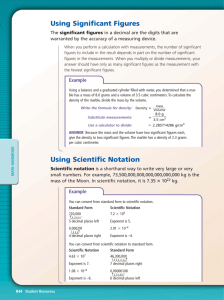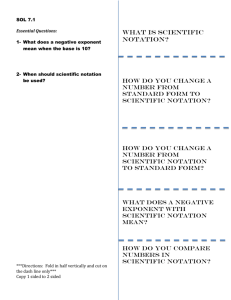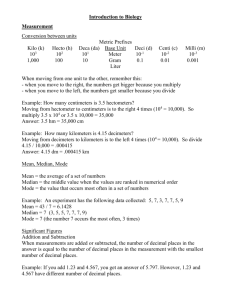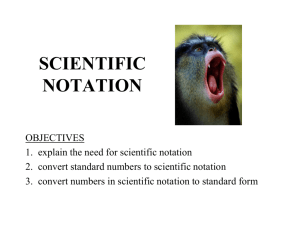Scientific Notation
advertisement
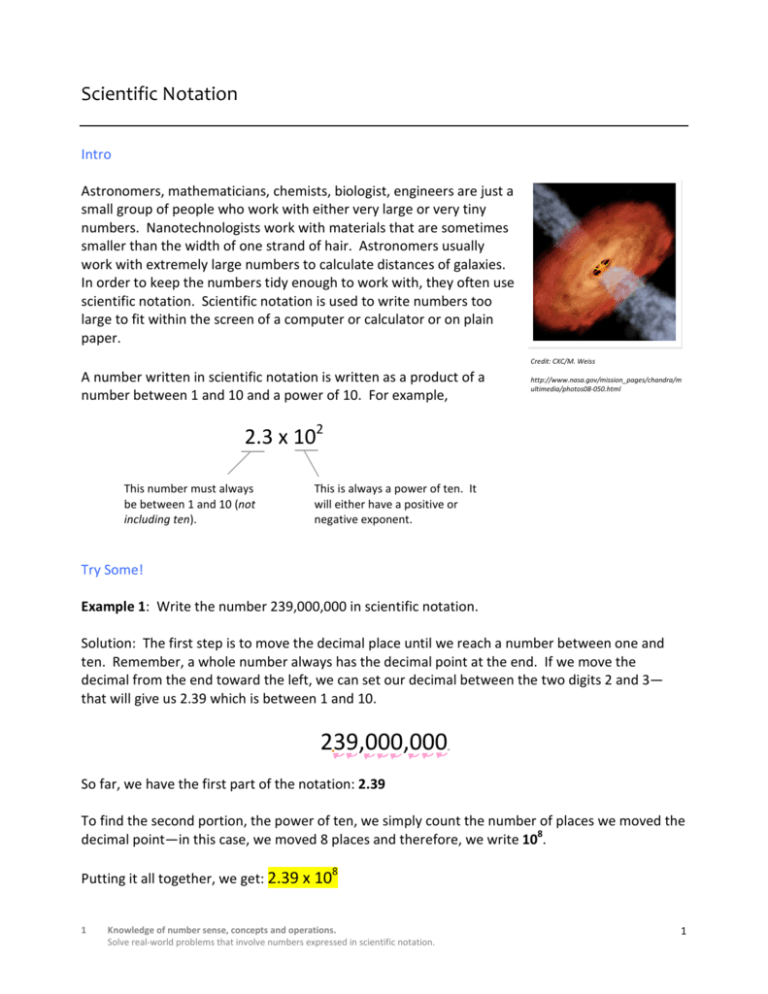
Scientific Notation Intro Astronomers, mathematicians, chemists, biologist, engineers are just a small group of people who work with either very large or very tiny numbers. Nanotechnologists work with materials that are sometimes smaller than the width of one strand of hair. Astronomers usually work with extremely large numbers to calculate distances of galaxies. In order to keep the numbers tidy enough to work with, they often use scientific notation. Scientific notation is used to write numbers too large to fit within the screen of a computer or calculator or on plain paper. Credit: CXC/M. Weiss A number written in scientific notation is written as a product of a number between 1 and 10 and a power of 10. For example, http://www.nasa.gov/mission_pages/chandra/m ultimedia/photos08-050.html 2.3 x 102 This number must always be between 1 and 10 (not including ten). This is always a power of ten. It will either have a positive or negative exponent. Try Some! Example 1: Write the number 239,000,000 in scientific notation. Solution: The first step is to move the decimal place until we reach a number between one and ten. Remember, a whole number always has the decimal point at the end. If we move the decimal from the end toward the left, we can set our decimal between the two digits 2 and 3— that will give us 2.39 which is between 1 and 10. 239,000,000 . . So far, we have the first part of the notation: 2.39 To find the second portion, the power of ten, we simply count the number of places we moved the decimal point—in this case, we moved 8 places and therefore, we write 108. 8 Putting it all together, we get: 2.39 x 10 1 Knowledge of number sense, concepts and operations. Solve real-world problems that involve numbers expressed in scientific notation. 1 Example 2: Write 0.3942 in scientific notation. Solution: First, move the decimal until it is between to digits which give a number between 1 and 10. In this case, we move the decimal place toward the right one place to give us: 3.942. Since we moved one place toward the left, the power of ten becomes: 10-1. -1 Putting it all together, we get: 3.942 x 10 Now, I know you are probably wondering why we used a negative exponent in this example and a positive exponent in example 1. Moving the decimal left or right determines whether you have a negative or positive power of ten. Here is the rule I follow to help me determine whether I should use a positive or negative exponent: If your original number is larger than 1, use a positive exponent. If your original number is between 0 and 1, use a negative exponent. Example 3: Write 344.52 in scientific notation. Solution: First, move the decimal until it is between 3 and 4. Second, the decimal was moved 2 places toward the left (the exponent will be positive since our original number is larger than 1). 2 Putting it all together: 3.4452 x 10 Example 4: Write 0.003741 in scientific notation. Solution: First, move the decimal until it is between 3 and 7 (that will give us a value between 1 and 10). Second, the decimal was moved 3 units toward the right (the exponent will be negative since our original number is less than 1). 3 Putting it all together: 3.741 x 10 Using your Calculator When you use your calculator, you will notice and “E” displayed on your screen when you try to multiply really large numbers or divide really small numbers. The “E” stands for the power of ten in scientific notation. The screen to the right shows: 2.3 x 107. 1 Knowledge of number sense, concepts and operations. Solve real-world problems that involve numbers expressed in scientific notation. 2.3E7 2


